Social Innovation and Community Engagement Report for Business
VerifiedAdded on 2023/06/08
|11
|2920
|420
Report
AI Summary
This report delves into the realm of social innovation and community engagement, focusing on how businesses can leverage these concepts to enhance their public image and build stronger relationships with their stakeholders. The report begins with an executive summary and then provides a comprehensive overview of social innovation and community engagement theory, drawing on various scholarly sources. The core of the report proposes a specific social innovation, in this case, the development of an application by McDonalds that aids in identifying healthcare issues resulting from consuming its products. The report then rigorously examines the financial, environmental, and ethical implications of this proposed innovation, alongside its contribution to the common good. Finally, the report addresses a significant implementation challenge, namely, potential resistance from competitors and the need for user training, before concluding with a summary of key findings and recommendations. The report aims to provide a comprehensive understanding of the practical and theoretical aspects of social innovation within a business context, offering valuable insights for strategic development and community engagement.
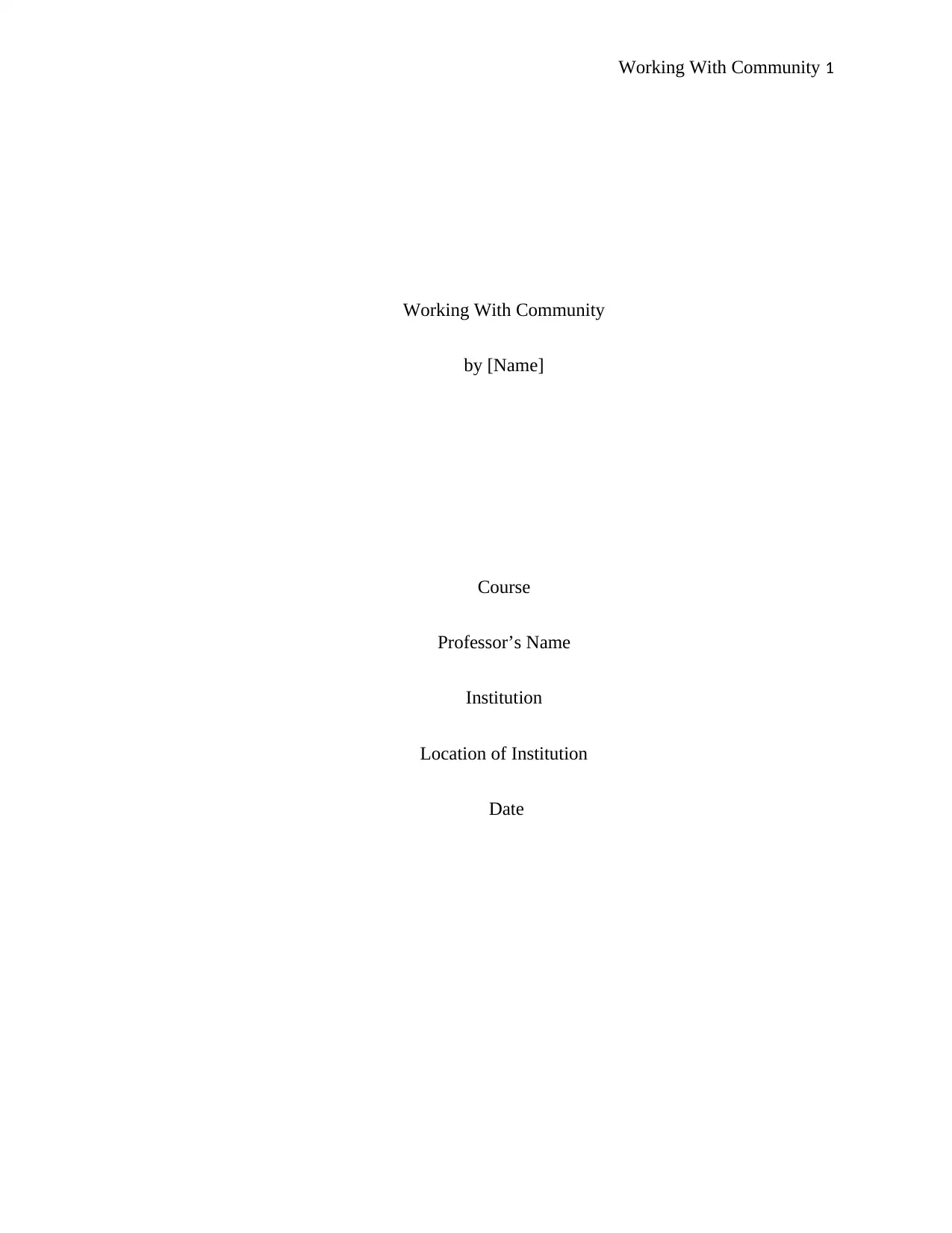
Working With Community 1
Working With Community
by [Name]
Course
Professor’s Name
Institution
Location of Institution
Date
Working With Community
by [Name]
Course
Professor’s Name
Institution
Location of Institution
Date
Paraphrase This Document
Need a fresh take? Get an instant paraphrase of this document with our AI Paraphraser
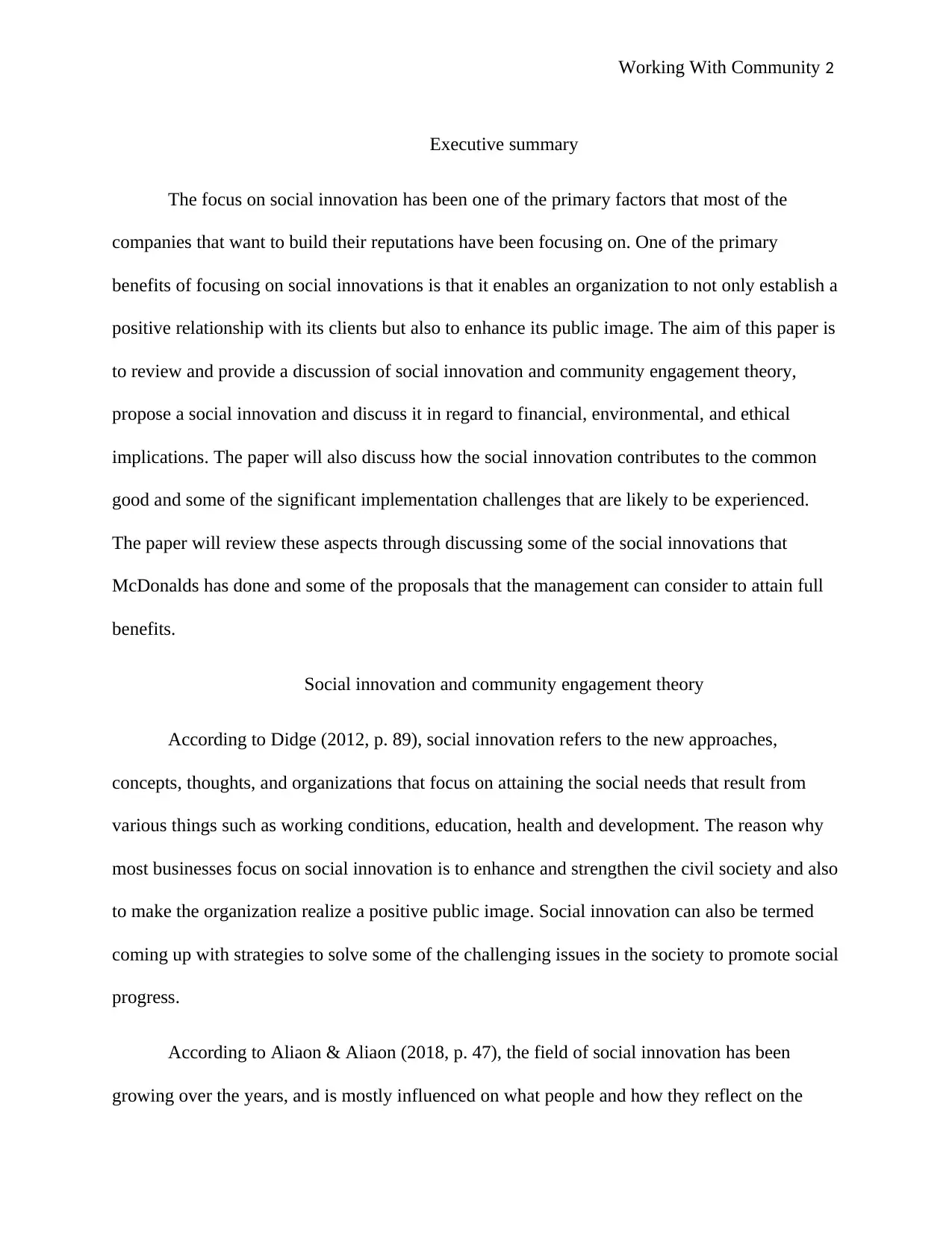
Working With Community 2
Executive summary
The focus on social innovation has been one of the primary factors that most of the
companies that want to build their reputations have been focusing on. One of the primary
benefits of focusing on social innovations is that it enables an organization to not only establish a
positive relationship with its clients but also to enhance its public image. The aim of this paper is
to review and provide a discussion of social innovation and community engagement theory,
propose a social innovation and discuss it in regard to financial, environmental, and ethical
implications. The paper will also discuss how the social innovation contributes to the common
good and some of the significant implementation challenges that are likely to be experienced.
The paper will review these aspects through discussing some of the social innovations that
McDonalds has done and some of the proposals that the management can consider to attain full
benefits.
Social innovation and community engagement theory
According to Didge (2012, p. 89), social innovation refers to the new approaches,
concepts, thoughts, and organizations that focus on attaining the social needs that result from
various things such as working conditions, education, health and development. The reason why
most businesses focus on social innovation is to enhance and strengthen the civil society and also
to make the organization realize a positive public image. Social innovation can also be termed
coming up with strategies to solve some of the challenging issues in the society to promote social
progress.
According to Aliaon & Aliaon (2018, p. 47), the field of social innovation has been
growing over the years, and is mostly influenced on what people and how they reflect on the
Executive summary
The focus on social innovation has been one of the primary factors that most of the
companies that want to build their reputations have been focusing on. One of the primary
benefits of focusing on social innovations is that it enables an organization to not only establish a
positive relationship with its clients but also to enhance its public image. The aim of this paper is
to review and provide a discussion of social innovation and community engagement theory,
propose a social innovation and discuss it in regard to financial, environmental, and ethical
implications. The paper will also discuss how the social innovation contributes to the common
good and some of the significant implementation challenges that are likely to be experienced.
The paper will review these aspects through discussing some of the social innovations that
McDonalds has done and some of the proposals that the management can consider to attain full
benefits.
Social innovation and community engagement theory
According to Didge (2012, p. 89), social innovation refers to the new approaches,
concepts, thoughts, and organizations that focus on attaining the social needs that result from
various things such as working conditions, education, health and development. The reason why
most businesses focus on social innovation is to enhance and strengthen the civil society and also
to make the organization realize a positive public image. Social innovation can also be termed
coming up with strategies to solve some of the challenging issues in the society to promote social
progress.
According to Aliaon & Aliaon (2018, p. 47), the field of social innovation has been
growing over the years, and is mostly influenced on what people and how they reflect on the
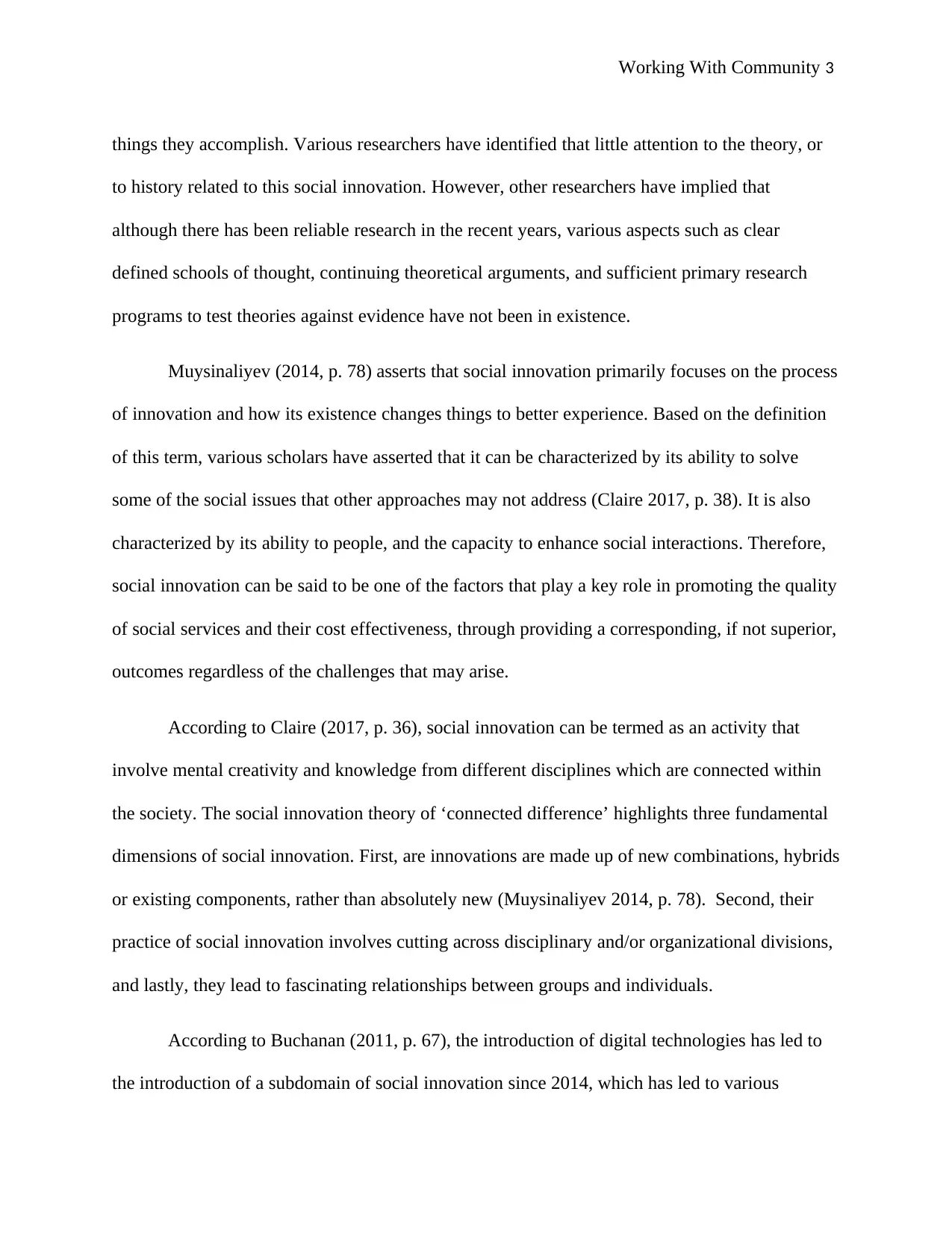
Working With Community 3
things they accomplish. Various researchers have identified that little attention to the theory, or
to history related to this social innovation. However, other researchers have implied that
although there has been reliable research in the recent years, various aspects such as clear
defined schools of thought, continuing theoretical arguments, and sufficient primary research
programs to test theories against evidence have not been in existence.
Muysinaliyev (2014, p. 78) asserts that social innovation primarily focuses on the process
of innovation and how its existence changes things to better experience. Based on the definition
of this term, various scholars have asserted that it can be characterized by its ability to solve
some of the social issues that other approaches may not address (Claire 2017, p. 38). It is also
characterized by its ability to people, and the capacity to enhance social interactions. Therefore,
social innovation can be said to be one of the factors that play a key role in promoting the quality
of social services and their cost effectiveness, through providing a corresponding, if not superior,
outcomes regardless of the challenges that may arise.
According to Claire (2017, p. 36), social innovation can be termed as an activity that
involve mental creativity and knowledge from different disciplines which are connected within
the society. The social innovation theory of ‘connected difference’ highlights three fundamental
dimensions of social innovation. First, are innovations are made up of new combinations, hybrids
or existing components, rather than absolutely new (Muysinaliyev 2014, p. 78). Second, their
practice of social innovation involves cutting across disciplinary and/or organizational divisions,
and lastly, they lead to fascinating relationships between groups and individuals.
According to Buchanan (2011, p. 67), the introduction of digital technologies has led to
the introduction of a subdomain of social innovation since 2014, which has led to various
things they accomplish. Various researchers have identified that little attention to the theory, or
to history related to this social innovation. However, other researchers have implied that
although there has been reliable research in the recent years, various aspects such as clear
defined schools of thought, continuing theoretical arguments, and sufficient primary research
programs to test theories against evidence have not been in existence.
Muysinaliyev (2014, p. 78) asserts that social innovation primarily focuses on the process
of innovation and how its existence changes things to better experience. Based on the definition
of this term, various scholars have asserted that it can be characterized by its ability to solve
some of the social issues that other approaches may not address (Claire 2017, p. 38). It is also
characterized by its ability to people, and the capacity to enhance social interactions. Therefore,
social innovation can be said to be one of the factors that play a key role in promoting the quality
of social services and their cost effectiveness, through providing a corresponding, if not superior,
outcomes regardless of the challenges that may arise.
According to Claire (2017, p. 36), social innovation can be termed as an activity that
involve mental creativity and knowledge from different disciplines which are connected within
the society. The social innovation theory of ‘connected difference’ highlights three fundamental
dimensions of social innovation. First, are innovations are made up of new combinations, hybrids
or existing components, rather than absolutely new (Muysinaliyev 2014, p. 78). Second, their
practice of social innovation involves cutting across disciplinary and/or organizational divisions,
and lastly, they lead to fascinating relationships between groups and individuals.
According to Buchanan (2011, p. 67), the introduction of digital technologies has led to
the introduction of a subdomain of social innovation since 2014, which has led to various
⊘ This is a preview!⊘
Do you want full access?
Subscribe today to unlock all pages.

Trusted by 1+ million students worldwide

Working With Community 4
changes in this aspect. The subdomain is known as digital social innovation and refers to a type
of social and collective innovation which innovators, its users, societies inter-relate through
using digital technologies to enhance knowledge and come up with solutions for different social
needs in the society.
Proposed social innovation.
Although there are so many types of social innovations which McDonalds can consider,
innovating an application that aids in identifying healthcare issues that result from consuming its
products can be a great one. According to Muller (2014, p. 65), most of the products that human
beings consume in the recent days are harmful to their health and therefore it is important to
make sound decisions on what to take and what to avoid. Although most of the consumers strive
to ensure they only consume health-friendly products, sometimes being able to understand the
safety of the products is challenging until they test the products to know the risks involved
(Didge 2012, p. 91). This means that if companies that produce food and beverage products such
as McDonalds invent test kits that can be used by its consumers to test the health risks associated
with their products, it can be possible to make decisions on whether to consume them or not.
Although introduction of these kits may have a negative impact on this company
especially on its sells, revenue and reputation, it can be a good way of showing that it is ethical
company which minds not only increasing its sales and revenues but also has a great interest in
promoting health of its consumers (Diane 2016, p. 68). Introducing the kit can also play a
significant role in promoting its reputation and also in making the society to view the company
as the best choice where they can purchase from. The kits, in this case, should show the
changes in this aspect. The subdomain is known as digital social innovation and refers to a type
of social and collective innovation which innovators, its users, societies inter-relate through
using digital technologies to enhance knowledge and come up with solutions for different social
needs in the society.
Proposed social innovation.
Although there are so many types of social innovations which McDonalds can consider,
innovating an application that aids in identifying healthcare issues that result from consuming its
products can be a great one. According to Muller (2014, p. 65), most of the products that human
beings consume in the recent days are harmful to their health and therefore it is important to
make sound decisions on what to take and what to avoid. Although most of the consumers strive
to ensure they only consume health-friendly products, sometimes being able to understand the
safety of the products is challenging until they test the products to know the risks involved
(Didge 2012, p. 91). This means that if companies that produce food and beverage products such
as McDonalds invent test kits that can be used by its consumers to test the health risks associated
with their products, it can be possible to make decisions on whether to consume them or not.
Although introduction of these kits may have a negative impact on this company
especially on its sells, revenue and reputation, it can be a good way of showing that it is ethical
company which minds not only increasing its sales and revenues but also has a great interest in
promoting health of its consumers (Diane 2016, p. 68). Introducing the kit can also play a
significant role in promoting its reputation and also in making the society to view the company
as the best choice where they can purchase from. The kits, in this case, should show the
Paraphrase This Document
Need a fresh take? Get an instant paraphrase of this document with our AI Paraphraser
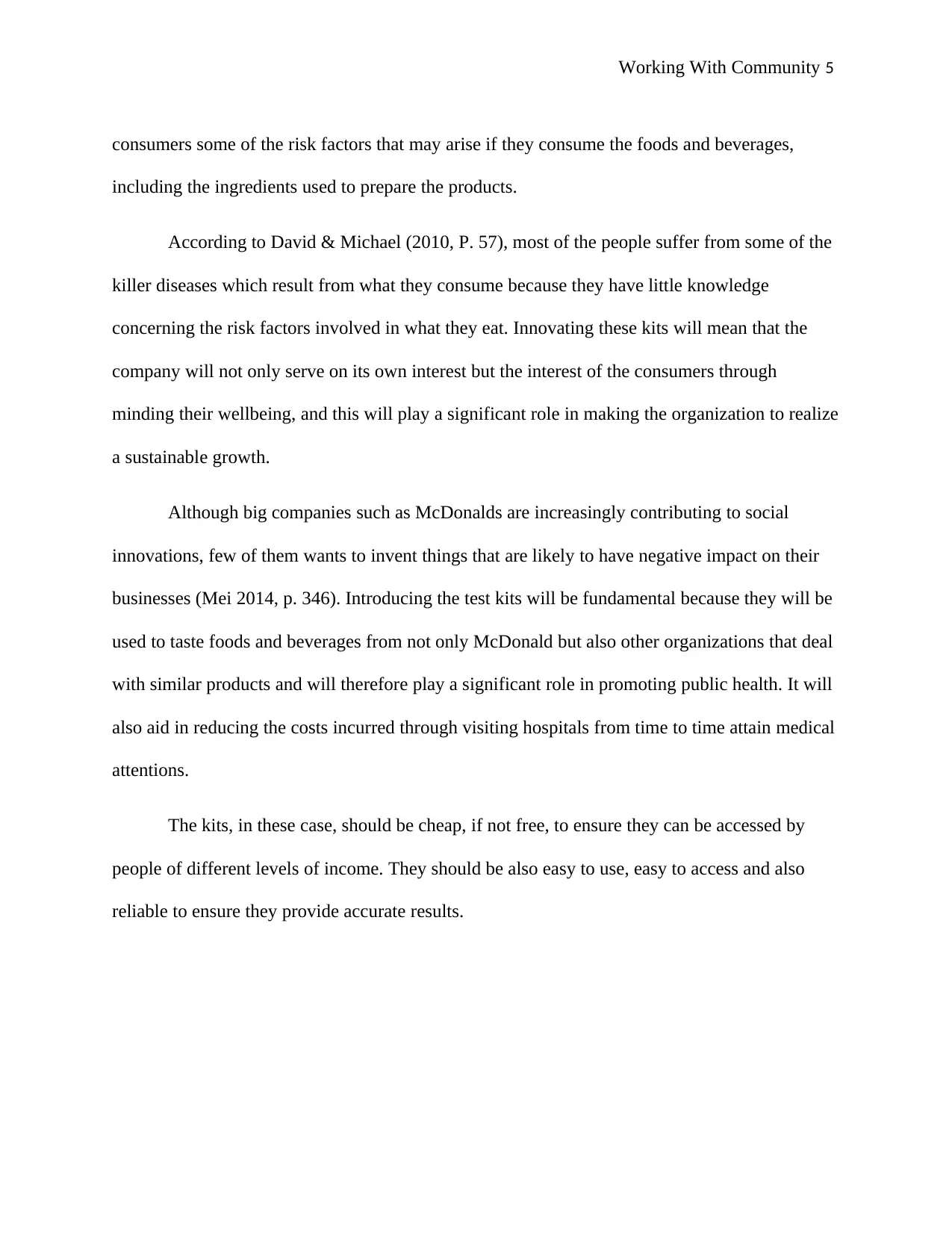
Working With Community 5
consumers some of the risk factors that may arise if they consume the foods and beverages,
including the ingredients used to prepare the products.
According to David & Michael (2010, P. 57), most of the people suffer from some of the
killer diseases which result from what they consume because they have little knowledge
concerning the risk factors involved in what they eat. Innovating these kits will mean that the
company will not only serve on its own interest but the interest of the consumers through
minding their wellbeing, and this will play a significant role in making the organization to realize
a sustainable growth.
Although big companies such as McDonalds are increasingly contributing to social
innovations, few of them wants to invent things that are likely to have negative impact on their
businesses (Mei 2014, p. 346). Introducing the test kits will be fundamental because they will be
used to taste foods and beverages from not only McDonald but also other organizations that deal
with similar products and will therefore play a significant role in promoting public health. It will
also aid in reducing the costs incurred through visiting hospitals from time to time attain medical
attentions.
The kits, in these case, should be cheap, if not free, to ensure they can be accessed by
people of different levels of income. They should be also easy to use, easy to access and also
reliable to ensure they provide accurate results.
consumers some of the risk factors that may arise if they consume the foods and beverages,
including the ingredients used to prepare the products.
According to David & Michael (2010, P. 57), most of the people suffer from some of the
killer diseases which result from what they consume because they have little knowledge
concerning the risk factors involved in what they eat. Innovating these kits will mean that the
company will not only serve on its own interest but the interest of the consumers through
minding their wellbeing, and this will play a significant role in making the organization to realize
a sustainable growth.
Although big companies such as McDonalds are increasingly contributing to social
innovations, few of them wants to invent things that are likely to have negative impact on their
businesses (Mei 2014, p. 346). Introducing the test kits will be fundamental because they will be
used to taste foods and beverages from not only McDonald but also other organizations that deal
with similar products and will therefore play a significant role in promoting public health. It will
also aid in reducing the costs incurred through visiting hospitals from time to time attain medical
attentions.
The kits, in these case, should be cheap, if not free, to ensure they can be accessed by
people of different levels of income. They should be also easy to use, easy to access and also
reliable to ensure they provide accurate results.
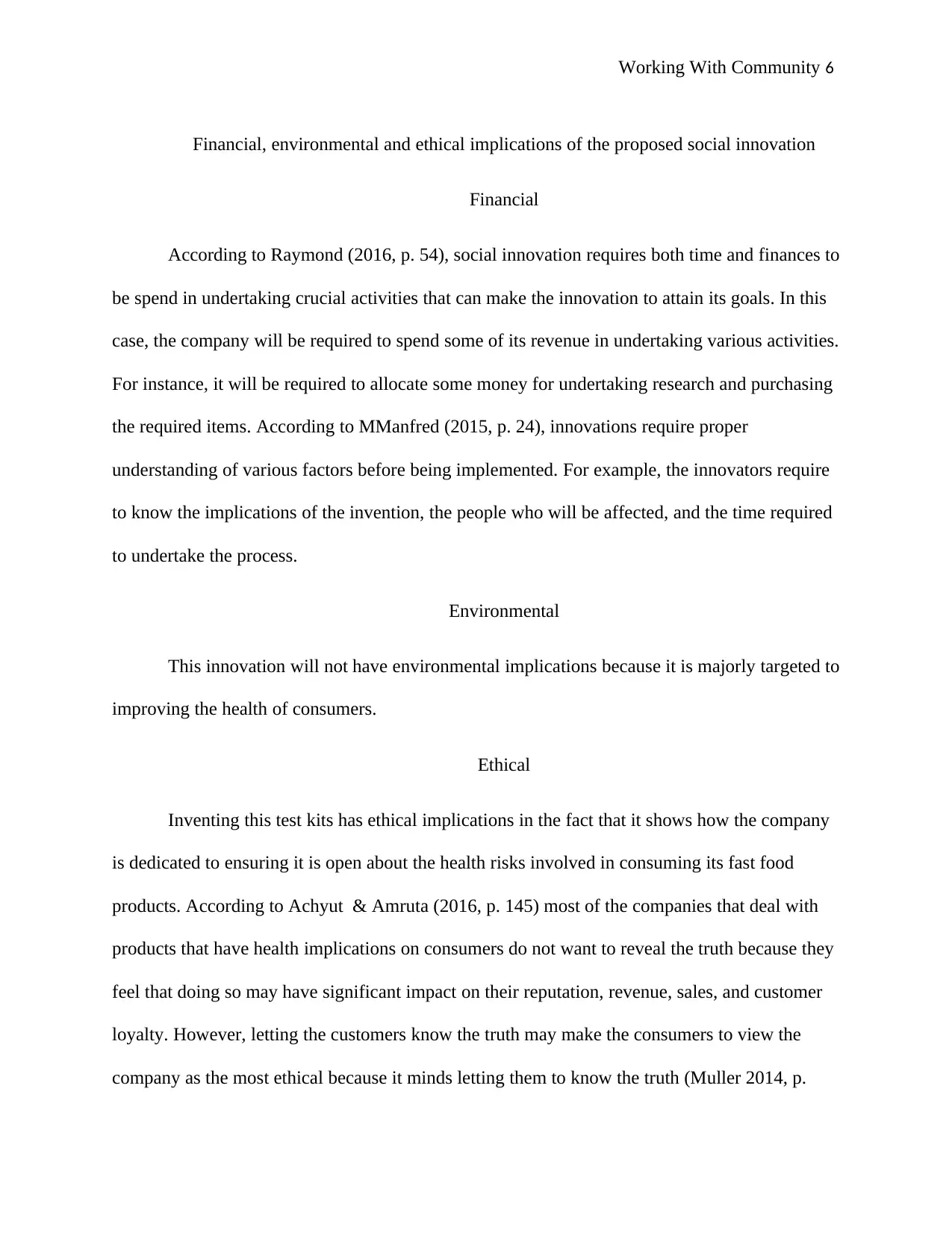
Working With Community 6
Financial, environmental and ethical implications of the proposed social innovation
Financial
According to Raymond (2016, p. 54), social innovation requires both time and finances to
be spend in undertaking crucial activities that can make the innovation to attain its goals. In this
case, the company will be required to spend some of its revenue in undertaking various activities.
For instance, it will be required to allocate some money for undertaking research and purchasing
the required items. According to MManfred (2015, p. 24), innovations require proper
understanding of various factors before being implemented. For example, the innovators require
to know the implications of the invention, the people who will be affected, and the time required
to undertake the process.
Environmental
This innovation will not have environmental implications because it is majorly targeted to
improving the health of consumers.
Ethical
Inventing this test kits has ethical implications in the fact that it shows how the company
is dedicated to ensuring it is open about the health risks involved in consuming its fast food
products. According to Achyut & Amruta (2016, p. 145) most of the companies that deal with
products that have health implications on consumers do not want to reveal the truth because they
feel that doing so may have significant impact on their reputation, revenue, sales, and customer
loyalty. However, letting the customers know the truth may make the consumers to view the
company as the most ethical because it minds letting them to know the truth (Muller 2014, p.
Financial, environmental and ethical implications of the proposed social innovation
Financial
According to Raymond (2016, p. 54), social innovation requires both time and finances to
be spend in undertaking crucial activities that can make the innovation to attain its goals. In this
case, the company will be required to spend some of its revenue in undertaking various activities.
For instance, it will be required to allocate some money for undertaking research and purchasing
the required items. According to MManfred (2015, p. 24), innovations require proper
understanding of various factors before being implemented. For example, the innovators require
to know the implications of the invention, the people who will be affected, and the time required
to undertake the process.
Environmental
This innovation will not have environmental implications because it is majorly targeted to
improving the health of consumers.
Ethical
Inventing this test kits has ethical implications in the fact that it shows how the company
is dedicated to ensuring it is open about the health risks involved in consuming its fast food
products. According to Achyut & Amruta (2016, p. 145) most of the companies that deal with
products that have health implications on consumers do not want to reveal the truth because they
feel that doing so may have significant impact on their reputation, revenue, sales, and customer
loyalty. However, letting the customers know the truth may make the consumers to view the
company as the most ethical because it minds letting them to know the truth (Muller 2014, p.
⊘ This is a preview!⊘
Do you want full access?
Subscribe today to unlock all pages.

Trusted by 1+ million students worldwide
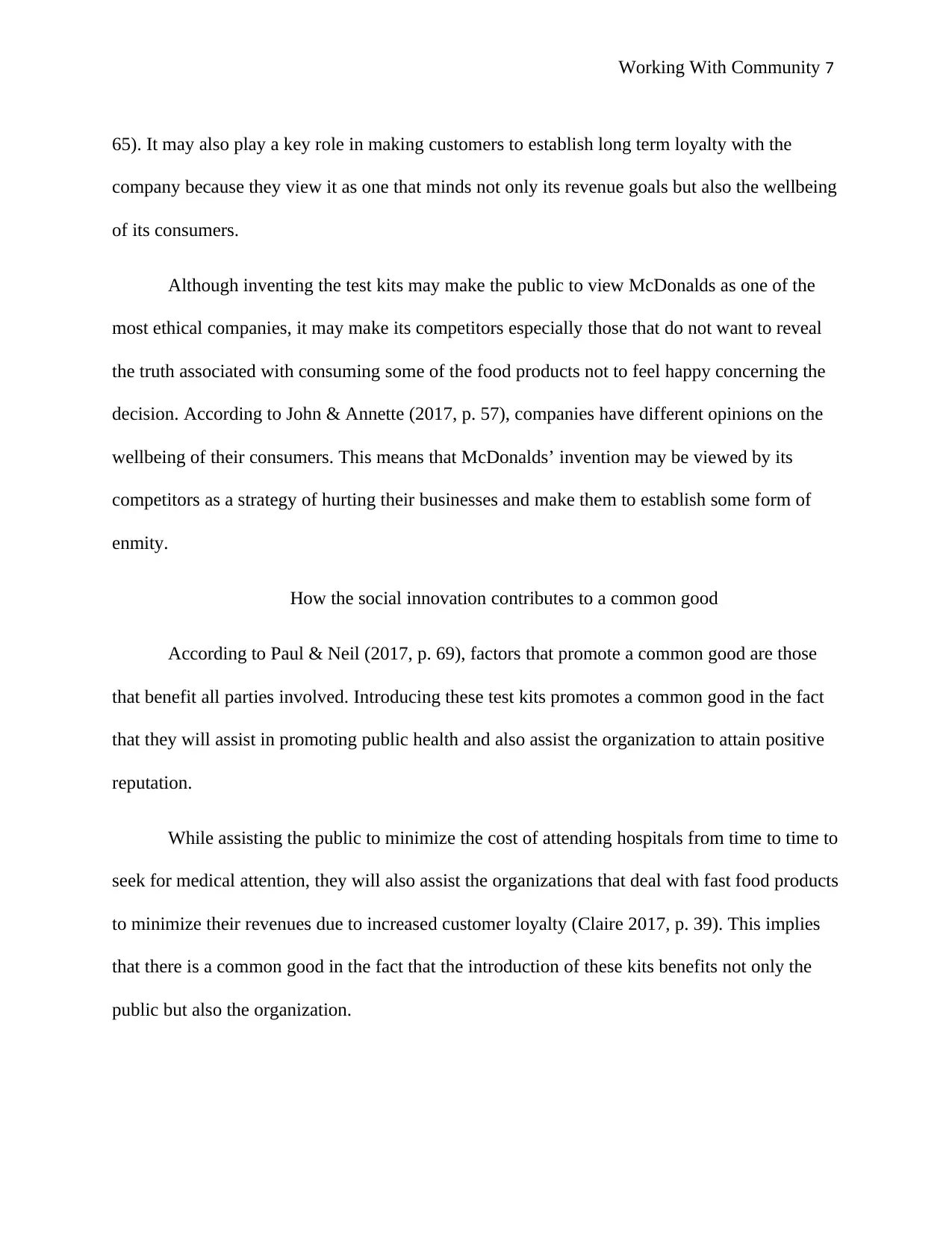
Working With Community 7
65). It may also play a key role in making customers to establish long term loyalty with the
company because they view it as one that minds not only its revenue goals but also the wellbeing
of its consumers.
Although inventing the test kits may make the public to view McDonalds as one of the
most ethical companies, it may make its competitors especially those that do not want to reveal
the truth associated with consuming some of the food products not to feel happy concerning the
decision. According to John & Annette (2017, p. 57), companies have different opinions on the
wellbeing of their consumers. This means that McDonalds’ invention may be viewed by its
competitors as a strategy of hurting their businesses and make them to establish some form of
enmity.
How the social innovation contributes to a common good
According to Paul & Neil (2017, p. 69), factors that promote a common good are those
that benefit all parties involved. Introducing these test kits promotes a common good in the fact
that they will assist in promoting public health and also assist the organization to attain positive
reputation.
While assisting the public to minimize the cost of attending hospitals from time to time to
seek for medical attention, they will also assist the organizations that deal with fast food products
to minimize their revenues due to increased customer loyalty (Claire 2017, p. 39). This implies
that there is a common good in the fact that the introduction of these kits benefits not only the
public but also the organization.
65). It may also play a key role in making customers to establish long term loyalty with the
company because they view it as one that minds not only its revenue goals but also the wellbeing
of its consumers.
Although inventing the test kits may make the public to view McDonalds as one of the
most ethical companies, it may make its competitors especially those that do not want to reveal
the truth associated with consuming some of the food products not to feel happy concerning the
decision. According to John & Annette (2017, p. 57), companies have different opinions on the
wellbeing of their consumers. This means that McDonalds’ invention may be viewed by its
competitors as a strategy of hurting their businesses and make them to establish some form of
enmity.
How the social innovation contributes to a common good
According to Paul & Neil (2017, p. 69), factors that promote a common good are those
that benefit all parties involved. Introducing these test kits promotes a common good in the fact
that they will assist in promoting public health and also assist the organization to attain positive
reputation.
While assisting the public to minimize the cost of attending hospitals from time to time to
seek for medical attention, they will also assist the organizations that deal with fast food products
to minimize their revenues due to increased customer loyalty (Claire 2017, p. 39). This implies
that there is a common good in the fact that the introduction of these kits benefits not only the
public but also the organization.
Paraphrase This Document
Need a fresh take? Get an instant paraphrase of this document with our AI Paraphraser
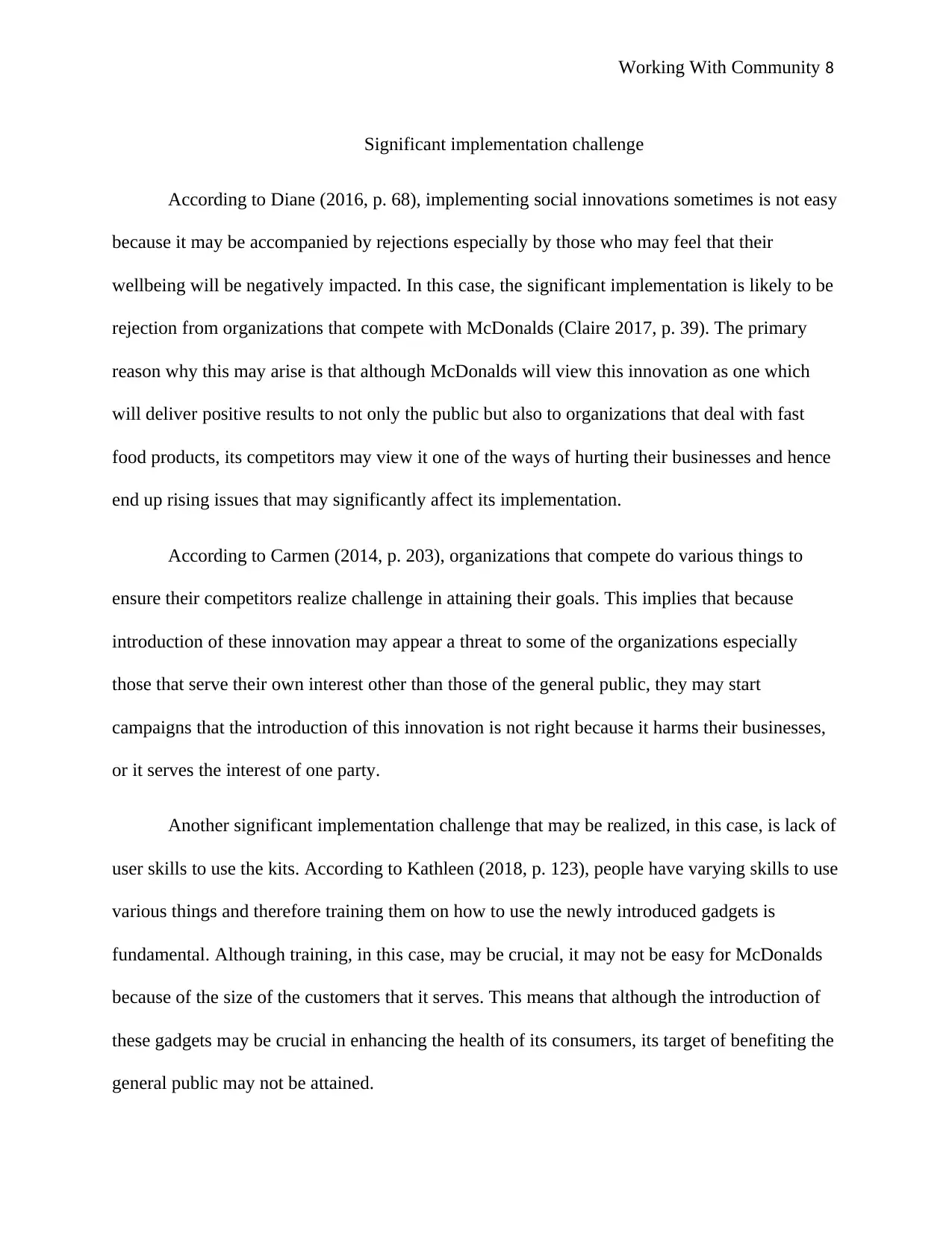
Working With Community 8
Significant implementation challenge
According to Diane (2016, p. 68), implementing social innovations sometimes is not easy
because it may be accompanied by rejections especially by those who may feel that their
wellbeing will be negatively impacted. In this case, the significant implementation is likely to be
rejection from organizations that compete with McDonalds (Claire 2017, p. 39). The primary
reason why this may arise is that although McDonalds will view this innovation as one which
will deliver positive results to not only the public but also to organizations that deal with fast
food products, its competitors may view it one of the ways of hurting their businesses and hence
end up rising issues that may significantly affect its implementation.
According to Carmen (2014, p. 203), organizations that compete do various things to
ensure their competitors realize challenge in attaining their goals. This implies that because
introduction of these innovation may appear a threat to some of the organizations especially
those that serve their own interest other than those of the general public, they may start
campaigns that the introduction of this innovation is not right because it harms their businesses,
or it serves the interest of one party.
Another significant implementation challenge that may be realized, in this case, is lack of
user skills to use the kits. According to Kathleen (2018, p. 123), people have varying skills to use
various things and therefore training them on how to use the newly introduced gadgets is
fundamental. Although training, in this case, may be crucial, it may not be easy for McDonalds
because of the size of the customers that it serves. This means that although the introduction of
these gadgets may be crucial in enhancing the health of its consumers, its target of benefiting the
general public may not be attained.
Significant implementation challenge
According to Diane (2016, p. 68), implementing social innovations sometimes is not easy
because it may be accompanied by rejections especially by those who may feel that their
wellbeing will be negatively impacted. In this case, the significant implementation is likely to be
rejection from organizations that compete with McDonalds (Claire 2017, p. 39). The primary
reason why this may arise is that although McDonalds will view this innovation as one which
will deliver positive results to not only the public but also to organizations that deal with fast
food products, its competitors may view it one of the ways of hurting their businesses and hence
end up rising issues that may significantly affect its implementation.
According to Carmen (2014, p. 203), organizations that compete do various things to
ensure their competitors realize challenge in attaining their goals. This implies that because
introduction of these innovation may appear a threat to some of the organizations especially
those that serve their own interest other than those of the general public, they may start
campaigns that the introduction of this innovation is not right because it harms their businesses,
or it serves the interest of one party.
Another significant implementation challenge that may be realized, in this case, is lack of
user skills to use the kits. According to Kathleen (2018, p. 123), people have varying skills to use
various things and therefore training them on how to use the newly introduced gadgets is
fundamental. Although training, in this case, may be crucial, it may not be easy for McDonalds
because of the size of the customers that it serves. This means that although the introduction of
these gadgets may be crucial in enhancing the health of its consumers, its target of benefiting the
general public may not be attained.
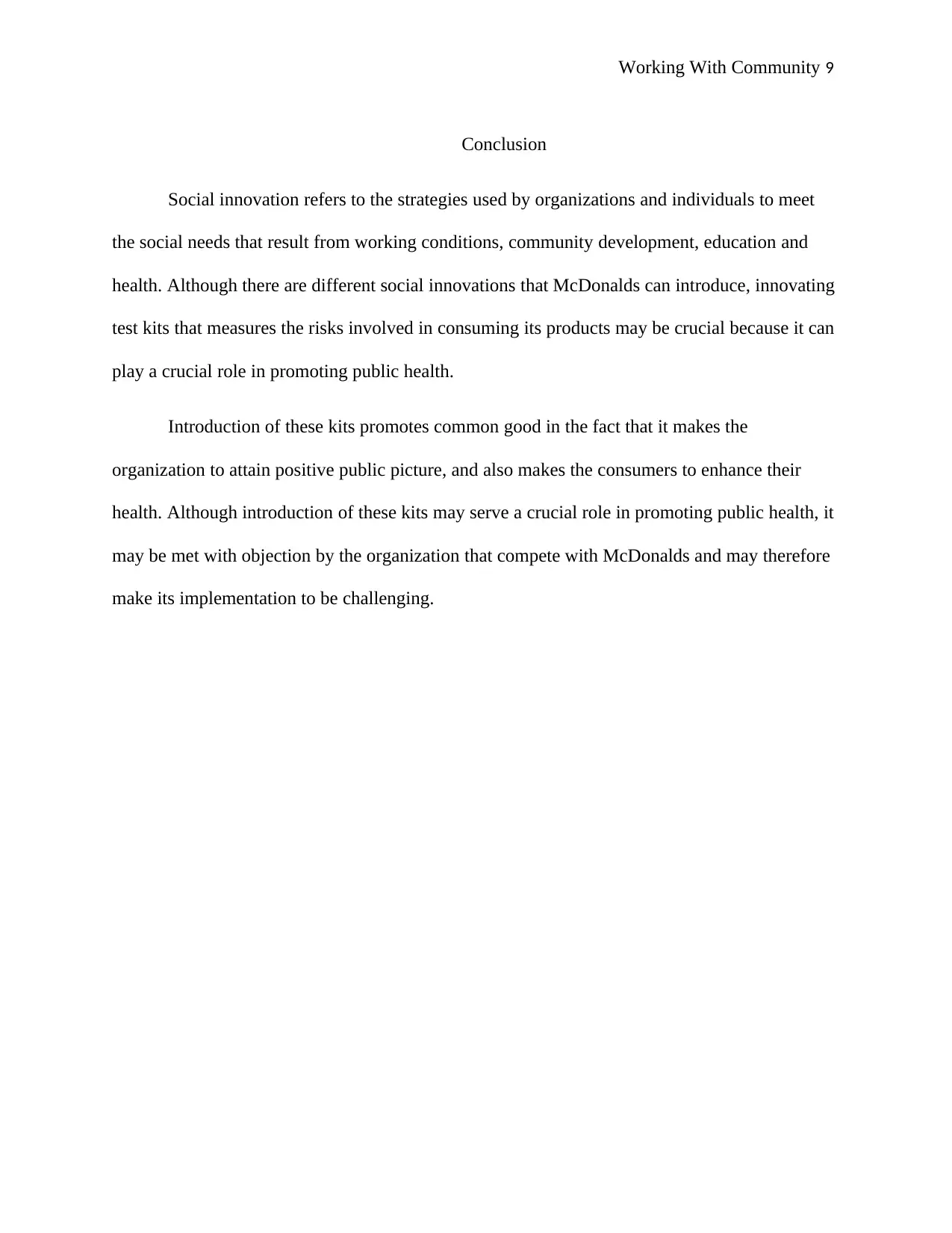
Working With Community 9
Conclusion
Social innovation refers to the strategies used by organizations and individuals to meet
the social needs that result from working conditions, community development, education and
health. Although there are different social innovations that McDonalds can introduce, innovating
test kits that measures the risks involved in consuming its products may be crucial because it can
play a crucial role in promoting public health.
Introduction of these kits promotes common good in the fact that it makes the
organization to attain positive public picture, and also makes the consumers to enhance their
health. Although introduction of these kits may serve a crucial role in promoting public health, it
may be met with objection by the organization that compete with McDonalds and may therefore
make its implementation to be challenging.
Conclusion
Social innovation refers to the strategies used by organizations and individuals to meet
the social needs that result from working conditions, community development, education and
health. Although there are different social innovations that McDonalds can introduce, innovating
test kits that measures the risks involved in consuming its products may be crucial because it can
play a crucial role in promoting public health.
Introduction of these kits promotes common good in the fact that it makes the
organization to attain positive public picture, and also makes the consumers to enhance their
health. Although introduction of these kits may serve a crucial role in promoting public health, it
may be met with objection by the organization that compete with McDonalds and may therefore
make its implementation to be challenging.
⊘ This is a preview!⊘
Do you want full access?
Subscribe today to unlock all pages.

Trusted by 1+ million students worldwide
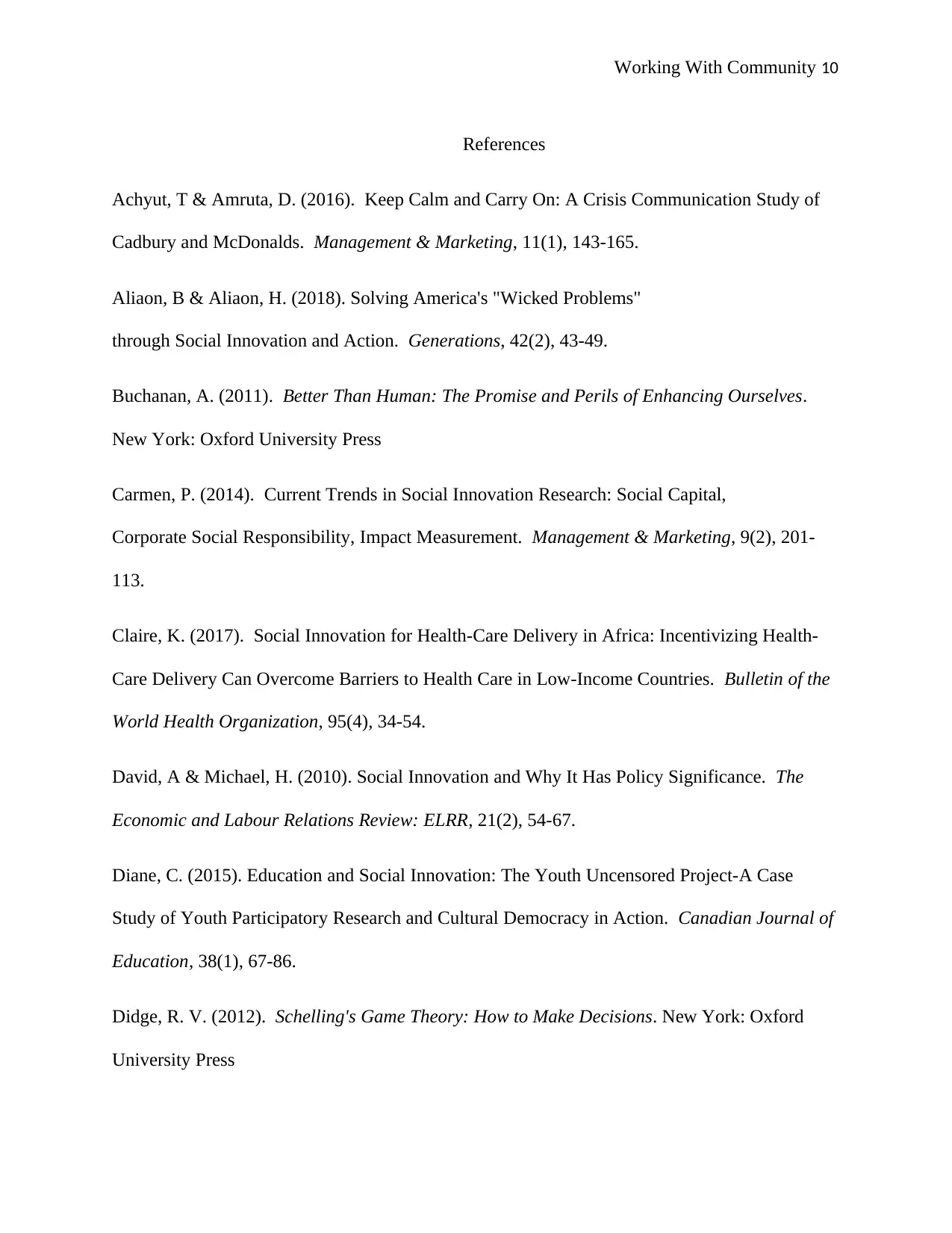
Working With Community 10
References
Achyut, T & Amruta, D. (2016). Keep Calm and Carry On: A Crisis Communication Study of
Cadbury and McDonalds. Management & Marketing, 11(1), 143-165.
Aliaon, B & Aliaon, H. (2018). Solving America's "Wicked Problems"
through Social Innovation and Action. Generations, 42(2), 43-49.
Buchanan, A. (2011). Better Than Human: The Promise and Perils of Enhancing Ourselves.
New York: Oxford University Press
Carmen, P. (2014). Current Trends in Social Innovation Research: Social Capital,
Corporate Social Responsibility, Impact Measurement. Management & Marketing, 9(2), 201-
113.
Claire, K. (2017). Social Innovation for Health-Care Delivery in Africa: Incentivizing Health-
Care Delivery Can Overcome Barriers to Health Care in Low-Income Countries. Bulletin of the
World Health Organization, 95(4), 34-54.
David, A & Michael, H. (2010). Social Innovation and Why It Has Policy Significance. The
Economic and Labour Relations Review: ELRR, 21(2), 54-67.
Diane, C. (2015). Education and Social Innovation: The Youth Uncensored Project-A Case
Study of Youth Participatory Research and Cultural Democracy in Action. Canadian Journal of
Education, 38(1), 67-86.
Didge, R. V. (2012). Schelling's Game Theory: How to Make Decisions. New York: Oxford
University Press
References
Achyut, T & Amruta, D. (2016). Keep Calm and Carry On: A Crisis Communication Study of
Cadbury and McDonalds. Management & Marketing, 11(1), 143-165.
Aliaon, B & Aliaon, H. (2018). Solving America's "Wicked Problems"
through Social Innovation and Action. Generations, 42(2), 43-49.
Buchanan, A. (2011). Better Than Human: The Promise and Perils of Enhancing Ourselves.
New York: Oxford University Press
Carmen, P. (2014). Current Trends in Social Innovation Research: Social Capital,
Corporate Social Responsibility, Impact Measurement. Management & Marketing, 9(2), 201-
113.
Claire, K. (2017). Social Innovation for Health-Care Delivery in Africa: Incentivizing Health-
Care Delivery Can Overcome Barriers to Health Care in Low-Income Countries. Bulletin of the
World Health Organization, 95(4), 34-54.
David, A & Michael, H. (2010). Social Innovation and Why It Has Policy Significance. The
Economic and Labour Relations Review: ELRR, 21(2), 54-67.
Diane, C. (2015). Education and Social Innovation: The Youth Uncensored Project-A Case
Study of Youth Participatory Research and Cultural Democracy in Action. Canadian Journal of
Education, 38(1), 67-86.
Didge, R. V. (2012). Schelling's Game Theory: How to Make Decisions. New York: Oxford
University Press
Paraphrase This Document
Need a fresh take? Get an instant paraphrase of this document with our AI Paraphraser
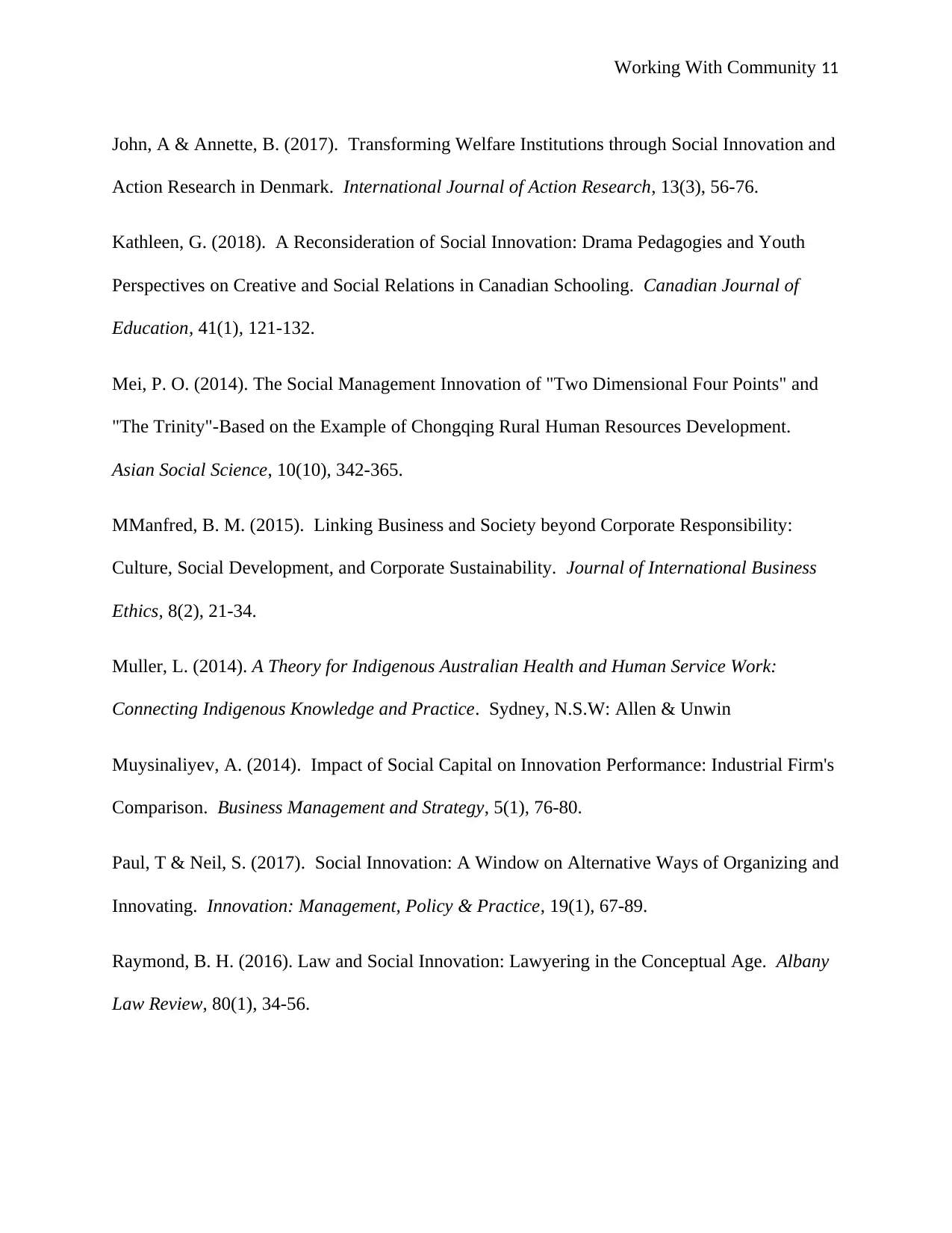
Working With Community 11
John, A & Annette, B. (2017). Transforming Welfare Institutions through Social Innovation and
Action Research in Denmark. International Journal of Action Research, 13(3), 56-76.
Kathleen, G. (2018). A Reconsideration of Social Innovation: Drama Pedagogies and Youth
Perspectives on Creative and Social Relations in Canadian Schooling. Canadian Journal of
Education, 41(1), 121-132.
Mei, P. O. (2014). The Social Management Innovation of "Two Dimensional Four Points" and
"The Trinity"-Based on the Example of Chongqing Rural Human Resources Development.
Asian Social Science, 10(10), 342-365.
MManfred, B. M. (2015). Linking Business and Society beyond Corporate Responsibility:
Culture, Social Development, and Corporate Sustainability. Journal of International Business
Ethics, 8(2), 21-34.
Muller, L. (2014). A Theory for Indigenous Australian Health and Human Service Work:
Connecting Indigenous Knowledge and Practice. Sydney, N.S.W: Allen & Unwin
Muysinaliyev, A. (2014). Impact of Social Capital on Innovation Performance: Industrial Firm's
Comparison. Business Management and Strategy, 5(1), 76-80.
Paul, T & Neil, S. (2017). Social Innovation: A Window on Alternative Ways of Organizing and
Innovating. Innovation: Management, Policy & Practice, 19(1), 67-89.
Raymond, B. H. (2016). Law and Social Innovation: Lawyering in the Conceptual Age. Albany
Law Review, 80(1), 34-56.
John, A & Annette, B. (2017). Transforming Welfare Institutions through Social Innovation and
Action Research in Denmark. International Journal of Action Research, 13(3), 56-76.
Kathleen, G. (2018). A Reconsideration of Social Innovation: Drama Pedagogies and Youth
Perspectives on Creative and Social Relations in Canadian Schooling. Canadian Journal of
Education, 41(1), 121-132.
Mei, P. O. (2014). The Social Management Innovation of "Two Dimensional Four Points" and
"The Trinity"-Based on the Example of Chongqing Rural Human Resources Development.
Asian Social Science, 10(10), 342-365.
MManfred, B. M. (2015). Linking Business and Society beyond Corporate Responsibility:
Culture, Social Development, and Corporate Sustainability. Journal of International Business
Ethics, 8(2), 21-34.
Muller, L. (2014). A Theory for Indigenous Australian Health and Human Service Work:
Connecting Indigenous Knowledge and Practice. Sydney, N.S.W: Allen & Unwin
Muysinaliyev, A. (2014). Impact of Social Capital on Innovation Performance: Industrial Firm's
Comparison. Business Management and Strategy, 5(1), 76-80.
Paul, T & Neil, S. (2017). Social Innovation: A Window on Alternative Ways of Organizing and
Innovating. Innovation: Management, Policy & Practice, 19(1), 67-89.
Raymond, B. H. (2016). Law and Social Innovation: Lawyering in the Conceptual Age. Albany
Law Review, 80(1), 34-56.
1 out of 11
Related Documents
Your All-in-One AI-Powered Toolkit for Academic Success.
+13062052269
info@desklib.com
Available 24*7 on WhatsApp / Email
![[object Object]](/_next/static/media/star-bottom.7253800d.svg)
Unlock your academic potential
Copyright © 2020–2025 A2Z Services. All Rights Reserved. Developed and managed by ZUCOL.





